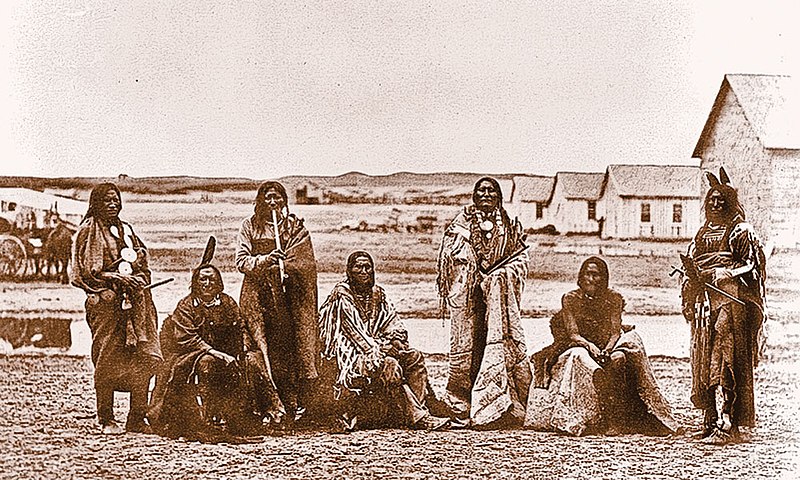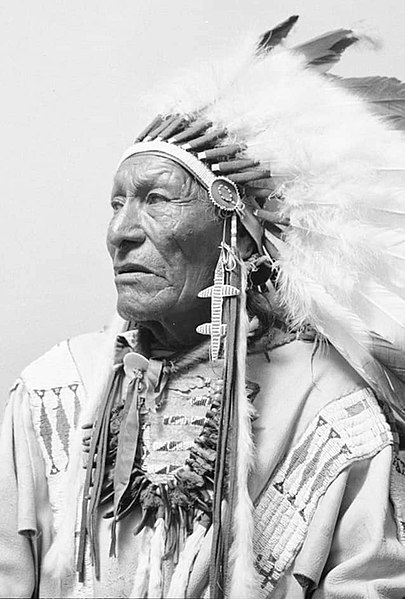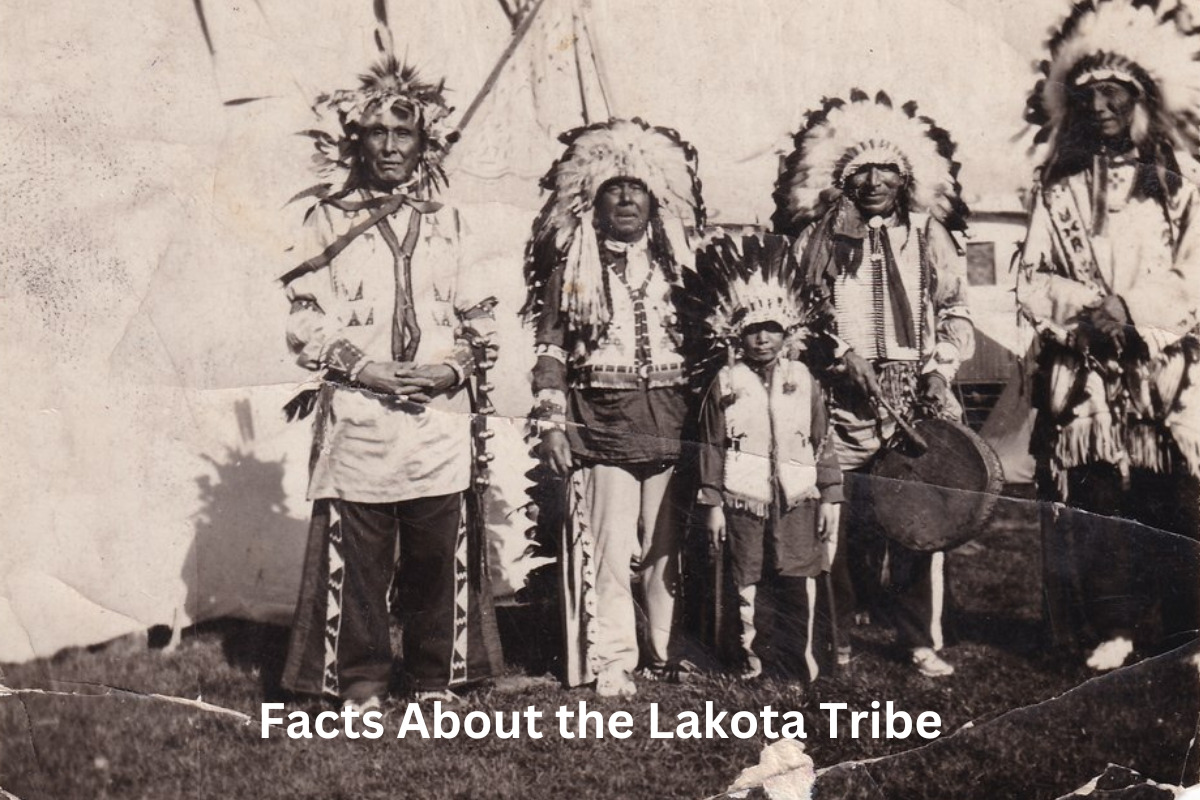The Lakota Tribe, also known as the Sioux, is a Native American tribe that holds a rich cultural heritage within the Great Plains region of the United States.
With a deep connection to their ancestral lands, the Lakota people have a profound understanding of the natural world and consider themselves the caretakers of the earth.
Their language, Lakȟótiyapi, is part of the Siouan language family, and efforts are being made to revitalize and preserve it. Organized into bands, Lakota society values consensus-based decision-making and upholds the wisdom of their elders.
They are renowned for their skilled horsemanship and warrior traditions, and their spirituality revolves around the belief in Wakan Tanka, the Great Spirit.
The buffalo holds immense cultural significance for the Lakota, and their art, storytelling, and oral traditions play a vital role in preserving their history and passing down knowledge.
Despite facing ongoing challenges, the Lakota Tribe is actively working towards economic development, healthcare improvements, and the preservation of their cultural heritage.
Lakota Tribe Facts
1. The Lakota Tribe, also known as the Sioux, is a Native American tribe that is part of the larger Sioux Nation
The Lakota Tribe, also known as the Sioux, is a Native American tribe that is part of the larger Sioux Nation. The Sioux Nation is composed of three major divisions:
- Lakota
- Dakota
- Nakota
The Lakota are the westernmost group and are further divided into seven bands:
- Oglala
- Brulé
- Hunkpapa
- Miniconjou
- Sihasapa
- Oohenumpa
- Itazipco
These bands have distinct histories, territories, and cultural traditions.

2. The Lakota people have a rich and deep cultural heritage that spans thousands of years
The Lakota people have a cultural heritage that spans thousands of years, rooted in their connection to the Great Plains and their ancestral traditions.
With a history deeply intertwined with the land they inhabit, the Lakota have developed a profound understanding of their environment, creating a way of life that harmonizes with nature.
Also Read: Facts About Crazy Horse
Their cultural heritage encompasses a wide range of aspects, including language, spirituality, art, music, dance, storytelling, and social organization.
The Lakota language, Lakȟótiyapi, is a testament to their heritage, serving as a vessel for their traditions, values, and worldview. Through their language, the Lakota convey their history, express their thoughts, and pass down their cultural knowledge from one generation to another.
3. The Lakota language is part of the Siouan language family and is still spoken by some tribal members today
The Lakota language, also known as Lakȟótiyapi, is part of the Siouan language family. It is a complex and polysynthetic language, which means that words are formed by combining multiple morphemes to convey meaning.
Also Read: Crow Tribe Facts
The Lakota language is highly valued by the Lakota people as it embodies their cultural identity and holds the wisdom of their ancestors. However, the language has faced challenges over the years, including suppression during the era of Indian boarding schools and the resulting decline in fluent speakers.
In recent years, efforts have been made to revitalize the Lakota language. Language immersion programs, community classes, and the use of technology, such as online resources and language apps, are helping to preserve and promote the Lakota language. These efforts are crucial for maintaining cultural heritage and ensuring that future generations can connect with their roots.
4. Lakota society is organized into bands or communities, each with its own leadership structure
Lakota society is traditionally organized into bands or communities, each with its own leadership structure. Historically, Lakota bands were led by a chief and a council of respected elders and leaders. Decision-making within the community was often based on consensus, with a focus on maintaining harmony and balance.
The chief’s role extended beyond leadership in times of conflict to include mediation, diplomacy, and ensuring the welfare of the community. Leadership positions were not necessarily hereditary but earned through acts of bravery, wisdom, and the ability to lead effectively. The Lakota valued the wisdom and guidance of their elders, who held important roles as keepers of knowledge and tradition.
Today, while the traditional leadership structures remain influential, the Lakota Tribe also has elected tribal governments and councils that work within the framework of federal and state laws. These governments advocate for the rights and interests of the Lakota people, manage tribal affairs, and promote economic development and cultural preservation.

5. The Lakota are known for their skilled horsemanship and were highly regarded as warriors
The Lakota are known for their skilled horsemanship and were highly regarded as warriors. The introduction of horses to the Plains in the 17th century transformed Lakota society and greatly enhanced their mobility, hunting capabilities, and military prowess.
Horses became an integral part of Lakota culture, providing a means of transportation, facilitating buffalo hunts, and enabling warfare and inter-tribal conflicts.
Lakota warriors were known for their bravery, agility, and strategic skills. They developed innovative tactics, such as mounted warfare and decoy maneuvers, which gave them a distinct advantage in battles.
The Battle of Little Bighorn in 1876, where Lakota leader Sitting Bull and his followers achieved a significant victory over General Custer and the U.S. Army, is one of the most notable examples of Lakota warrior prowess.
6. The Lakota have a spiritual tradition centered around the belief in Wakan Tanka, the Great Spirit
The Lakota have a spiritual tradition deeply rooted in their beliefs and connection to the natural world. Central to their spiritual practices is the belief in Wakan Tanka, the Great Spirit, who is present in all aspects of life.
The Lakota view the world as an interconnected web, where humans, animals, plants, and the environment are all part of a larger whole.
The Lakota engage in various sacred ceremonies that are essential for their spiritual and cultural identity. One of the most prominent ceremonies is the Sun Dance, a powerful and demanding ritual that involves fasting, prayer, and physical endurance. It is a time for community renewal, spiritual cleansing, and the expression of gratitude to the Great Spirit.
Sweat Lodge ceremonies are also significant to the Lakota. These ceremonies involve entering a small, dome-shaped structure heated by stones. Participants engage in prayer, song, and purification rituals, seeking spiritual guidance, healing, and connection with the spiritual realm.
Dreams hold particular importance in Lakota spirituality. They are believed to be a means of communication between individuals and the spirit world, offering guidance, prophecies, and messages from ancestors or animal spirits.
The interpretation and understanding of dreams play a vital role in the spiritual and personal development of individuals within the Lakota community.
7. Buffalo, or Tatanka, hold great importance in Lakota culture
Buffalo, or Tatanka, hold great importance in Lakota culture. Historically, the buffalo provided the Lakota with food, clothing, shelter, and tools, making them a vital resource for survival.
The Lakota had a deep respect and reverence for the buffalo, considering them sacred and viewing them as relatives. The buffalo hunt was a central aspect of their way of life, and it was conducted with great ceremony and respect.
Buffalo hunts were communal activities that involved careful planning and coordination. The Lakota developed skilled hunting techniques, including the use of buffalo jumps, where herds were driven off cliffs to minimize waste and maximize resources.
Every part of the buffalo was utilized—meat was preserved and consumed, hides were used for clothing and shelter, bones were made into tools, and sinews were used for binding.
Today, the Lakota continue to honor the buffalo through ceremonies, songs, dances, and artwork. Efforts are also being made to restore and conserve buffalo herds on tribal lands, as the return of the buffalo is seen as a symbol of cultural revitalization and sovereignty.
8. Lakota art is characterized by intricate beadwork, quillwork, and traditional clothing
Lakota art is characterized by intricate beadwork, quillwork, and traditional clothing adorned with vibrant colors and meaningful designs. Beadwork and quillwork hold significant cultural and artistic value, often depicting important symbols, stories, and spiritual motifs.
Lakota artisans display their craftsmanship through the creation of items such as moccasins, bags, clothing, and regalia for ceremonies and powwows.
The Lakota are also known for their skill in crafting tipis, the iconic conical dwellings that provided them with portable and practical shelter. Tipis were constructed using wooden poles and covered with buffalo hides, which were often decorated with paintings depicting personal or tribal symbols.
Drum-making is another important artistic tradition among the Lakota. The drum holds spiritual significance and is used in ceremonies and social gatherings. The drum represents the heartbeat of the Lakota people and serves as a connection to their ancestors and the spirit world.
9. Lakota storytelling and oral tradition are vital for passing down history, values, and teachings from one generation to another
Lakota storytelling and oral tradition are vital for passing down history, values, and teachings from one generation to another. Storytelling is considered an art form and an educational tool, conveying moral lessons, cultural knowledge, and the wisdom of the Lakota ancestors.
Elders play a crucial role as storytellers, sharing myths, legends, and personal narratives that provide insights into the Lakota way of life.
These stories often center around themes of bravery, respect for nature, the importance of community, and the consequences of actions. Through storytelling, the Lakota preserve their cultural heritage, reinforce their identity, and instill values and traditions in younger generations.
10. Today, the Lakota Tribe faces ongoing challenges related to economic development, health disparities, and the preservation of their cultural heritage
Today, the Lakota Tribe faces ongoing challenges related to economic development, health disparities, and the preservation of their cultural heritage.
Like many Native American tribes, the Lakota have experienced historical trauma, including forced relocation, loss of land, and attempts to assimilate their culture. These challenges have had long-lasting effects on the well-being and self-determination of the Lakota people.
Efforts are being made within the Lakota community and by external organizations to address these challenges and support the tribe. Initiatives focus on economic development through the promotion of sustainable businesses, education, and job creation.
There are also programs aimed at improving healthcare access, addressing substance abuse issues, and promoting overall wellness.
Cultural preservation remains a priority for the Lakota Tribe. Language revitalization programs, cultural centers, and educational initiatives are in place to ensure that Lakota traditions, ceremonies, and knowledge are passed down to future generations. Collaboration with universities, museums, and anthropologists also contributes to the preservation and documentation of Lakota history and cultural practices.
